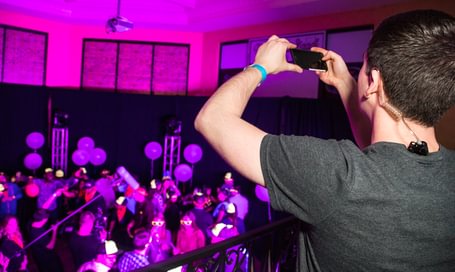Unleashing the Magic of Motion Design

Motion design is part of almost every video. It goes way beyond videos only made from graphics and animation. It might be the perfectly designed text board or deployed to bring a user-interface to life.
The basket of motion design is filled with all sorts of goodies. There’s something for everyone and there’s a lot to reviews.
So, let’s dive in.
Motion and Design
So, what is animation? Or motion design? Or whatever you call it?
There are two important words here: motion & design.
Actually, it’s design & motion.
First, you need to design with animation in mind. An incredible animator may be great at design, but if you start with poor design quality, you’ll get a poor animation. If you start with a bad story, you’ll get a bad video. So good, thoughtful, crafted design is the key first step. Mood boards, storyboards, golden frames are all part of the equation.
Then, you need to put these great designs in motion through animation. There is sometimes a lot of preparation to move a design into a world where it's ready for animation. Similarly, there are times when you design-to-animate by building everything in the program you’ll use to animate.
Animation is a vast and versatile art form that brings life and movement to still images or objects. There are various types of animation, each with its own unique characteristics and applications.
The Different Types of Animation and When to Use Them
Let's explore some of the most common types and when to use them:
2D Animation: 2D animation brings movement to images in a two-dimensional space. It is perfect for character animation, text boards, explainer videos, and a core part of most brand videos.
3D Animation: 3D animation creates objects and characters in a three-dimensional space. It is ideal for a more advanced style, showcasing products, abstract textures, but the main differentiator between 2D and 3D is really a style preference.
Stop Motion Animation: Stop motion animation involves manipulating physical objects or models one frame at a time. It adds a distinct and tactile quality when you want to avoid a computer generated style.
Motion Graphics: Motion graphics combine graphic design elements, text, and visual effects to create animated designs. They enhance visual storytelling and are commonly used in title sequences, logo animations, explainer videos, and infographics. Motion graphics is also a catchall term at times.
VFX Animation: VFX animation integrates CGI with live-action footage to create extraordinary visuals, set extension, and clean up. It is extensively used in movies, commercials, and video games to bring realistic simulations, explosions, creatures, and fantastical elements to life. It’s a tool that we often use to make shots look even better than we intended. Sometimes it’s as simple as just removing a microphone from a video.
Building on Brand Guidelines with Motion Design
Now how can motion design and branding play together?
Your brand probably has some guidelines. The dos and don’ts that unnerve your team when used incorrectly.
It’s easy to see a new video team hop onto a project and create new things. They’re excited to get their hands on your brand.
To prevent mistakes and misuses of your brand elements, it’s time to establish video guidelines. A great starting point is a library of motion design templates.
Motion design elements are crucial in maintaining a consistent and cohesive visual language across your video content. By incorporating elements such as logo animations, title boards, lower thirds, and name tags, you elevate your brand's identity and create a memorable viewing experience.
You also run into fewer issues and headaches down the road.
With tools like After Effects and motion graphic template files (mogrt files), you can build scalable and shareable files to align anyone putting your brand into motion with video.
These elements should align with your brand guidelines, using colors, typography, and design elements that reflect your brand's personality. A well-executed motion design system reinforces brand recognition and enhances the overall production value of your videos.

Using Visual Effects to Clean Up Shots or Create a New Look
Let’s enter the realm of visual effects.
Here we discover the power to erase unwanted bloopers, spruce up shots, and even conjure up brand-new worlds.
Who needs a magic wand when you have VFX at your fingertips (or Animus Studios).
Here’s where VFX comes in:
Cleaning Up Shots: Visual effects can fix imperfections and enhance shot quality. Remove unwanted elements like wires, microphones, orblemishes. Correct color imbalances, adjust lighting, or smooth camera movements.
Creating a New Look: Visual effects offer endless possibilities for transforming aesthetics. Apply VFX filters or effects to achieve a specific mood or style.
Seamless Integration: Ensure VFX elements seamlessly blend with footage. Pay attention to lighting, shadows, and reflections. Match color grading and visual style for a cohesive result.
Set Extension: When there isn’t quite enough room to film a whole shot, you can film part of it (or just an element) and build the rest of the world. Set extension can be as simple as extending a white wall to the edge of the frame or as complex as building a complex world around a character.
Enhancing Narrative or Storytelling: VFX can elevate storytelling. Create fantastical worlds, bring creatures to life, depict futuristic technologies or showcase real technology in use. Incorporate VFX strategically for captivating visual experiences.
Illustration: Where Art Meets Animation
With illustrations, you can unleash your inner artist and create visually captivating moments that leave a lasting impression on your audience.
Illustration can bring a more tactile style to your project and help to amplify human emotion. Often, the first thing that comes to mind with illustration project is a form of character animation.
Here are a few more reasons we love illustration:
Visual Appeal: Illustrations add a unique and visually appealing touch to videos, capturing viewers' attention and making the content visually engaging.
Branding and Identity: Branded illustrations reinforce brand recognition and create a cohesive visual experience, establishing a memorable brand presence. You have even more control than a live action video project.
Creativity and Artistic Expression: Illustrations allow for artistic expression, enabling the exploration of unique visual concepts and art styles.
Versatility and Adaptability: Illustrations doesn’t mean one thing. There are seamlessly integrate into different videos. Here’s an illustration [link to this] project that was born after an interview from a live action filming session.
Leveraging 3D Techniques for Added Depth and Realism
Strap on your 3D glasses. Now take them off. This isn’t that type of 3D (though we could tackle that if you’re interested).
With 3D techniques, your brand's vision can soar to new heights (sorry, new depths).
Here are some ways 3D can add depth to your videos:
Modeling: 3D modeling involves creating virtual objects and characters with three-dimensional geometry. By utilizing modeling techniques, you can bring depth and realism to your video by constructing lifelike environments, intricate objects, or detailed characters. If your team engineers products, you likely already have files we can leverage to speed up the process.
Texturing and Shading: Texturing and shading techniques add realism to 3D objects by applying textures, colors, and materials to their surfaces. By using textures and shaders, you can create the appearance of different materials such as wood, metal, fabric, or glass. These techniques add depth, dimension, and tactile qualities to objects, making them visually believable and enhancing the overall realism of your video.
Lighting and Shadows: Just like a live action filming with a camera, proper lighting and shadow techniques play a vital role in adding depth and realism to 3D scenes. By simulating various lighting conditions and utilizing techniques like global illumination or area lighting, you can create realistic lighting scenarios that enhance the visual depth of your video. Shadows cast by objects add an extra layer of realism, providing depth cues and grounding the objects within the scene.
Animation: 3D animation breathes life into virtual characters, objects, and environments. By animating movements, you can create realistic and dynamic scenes that engage viewers. Incorporating natural physics-based movements, facial expressions, or intricate interactions adds depth and realism to the visual storytelling.
Camera Techniques: Employing camera techniques in 3D enhances depth perception and adds realism to your video. By simulating camera movements such as panning, tracking, or zooming, you can create a sense of depth and immersion. Additionally, utilizing depth of field and focal length settings mimics real-world camera effects, further enhancing the perception of depth and adding a cinematic touch to your visuals.
Special Effects: 3D techniques allow for the creation of visually stunning special effects. From particle simulations to fluid dynamics, these effects add depth, realism, and visual impact to your video. Whether it's a swirling vortex, a fiery explosion, or a cascading waterfall, these effects often achieve what you simply can’t film.
Congratulations, you’ve read (or skimmed) a long blog article about motion design.
Now it’s time to leap into the world of motion, and let your imagination run wild. Or… it’s time to talk to a partner who can help.
Either way, let the magic begin!
P.S. Here’s a shortcut to that beginning. Reach out today and let’s build something really cool together.

